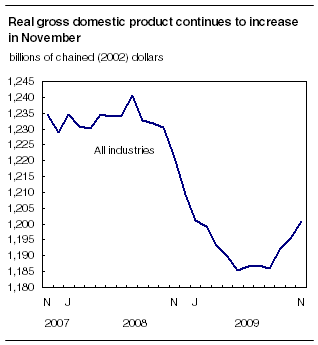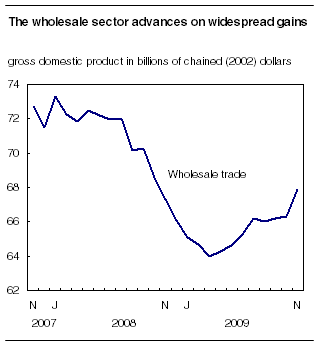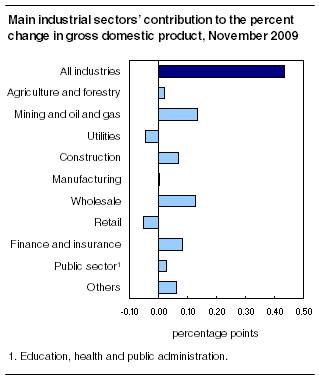Common menu bar links
Gross domestic product by industry
Archived Content
Information identified as archived is provided for reference, research or recordkeeping purposes. It is not subject to the Government of Canada Web Standards and has not been altered or updated since it was archived. Please "contact us" to request a format other than those available.
Related subjects
Real gross domestic product advanced 0.4% in November, a third consecutive monthly increase. As was the case in September and October, most major industrial sectors increased their production.

The goods-producing industries (+0.6%) grew for a third month in a row, while the services industries increased 0.4%. Mining and oil and gas extraction, and wholesale trade accounted for about 60% of the overall growth. Several other sectors also recorded increases, such as finance and insurance, construction and the public sector (education, health and public administration combined). Conversely, retail trade and utilities declined in November, while the manufacturing sector remained unchanged.
Mining and oil and gas extraction increases
The mining sector increased 1.8% in November, largely on the strength of oil and gas extraction. Natural gas production rose as prices, while remaining low compared with a year ago, increased recently. Oil extraction went up as foreign demand increased. Support activities for mining, oil and gas extraction advanced for a fourth month in a row.
Note to readers
The monthly gross domestic product (GDP) by industry data at basic prices are chained volume estimates with 2002 as their reference year. This means that the data for each industry and aggregate are obtained from a chained volume index multiplied by the industry's value added in 2002. For the 1997-to-2006 period, the monthly data are benchmarked to annually chained Fisher volume indexes of GDP obtained from the constant-price input-output tables.
For the period starting with January 2007, the data are derived by chaining a fixed-weight Laspeyres volume index to the prior period. The fixed weights are the industry output and input prices of 2006. This makes the monthly GDP by industry data more comparable with the expenditure-based GDP data, chained quarterly.
Revisions
With this release of monthly GDP by industry, revisions have been made back to January 2009. For more information about monthly GDP by industry, see the National Economic Accounts module on our website (www.statcan.gc.ca/nea-cen/index-eng.htm).
The mining sector excluding oil and gas extraction rose 2.5% as some producers in the copper, nickel, lead and zinc mining industry boosted their production after resuming their operations in October.
Widespread gains in wholesale trade
The volume of wholesaling activities increased 2.4% in November, with all trade groups advancing, with the exception of machinery and equipment, and metal products. The most notable increases were in the wholesaling of food products, motor vehicles (which recorded a 16% surge in imports) and building supplies.

The finance and insurance sector moves ahead
The finance and insurance sector grew 1.2% in November. This gain was attributable to strong activity in the bond markets and a significant increase in mutual fund sales. There was also strength in personal loans and residential mortgages.
Construction rises again
Construction activity rose 1.1% in November, a fourth consecutive monthly increase. Residential building construction (+2.5%) and, to a lesser extent, engineering and repair work (+0.6%) advanced. Non-residential building construction edged down as an increase in institutional building was more than offset by decreases in industrial and commercial building.
The home resale market continued to advance, resulting in a 0.7% increase in the output of real estate agents and brokers.
Retail trade decreases
Value added in retail trade fell 0.8% in November. Significant decreases were posted in the automotive sector, general merchandise stores (which include department stores), and clothing and accessories stores. On the other hand, increased activities at furniture, home furnishings and electronic stores as well as building materials stores partially offset the declines.

Output of utilities falls
The utilities sector decreased 1.8% in November as unseasonably warm weather throughout most of Canada lowered the demand for both electricity and natural gas.
Manufacturing sector remains unchanged
The manufacturing sector remained unchanged in November, following growth of 0.1% in October. Manufacturing of primary metal products, chemicals, non-metallic minerals, and petroleum and coal products increased significantly. Conversely, manufacturers of fabricated metal products, printing and food products reduced their production.
Available on CANSIM: table 379-0027.
Definitions, data sources and methods: survey number 1301.
The November 2009 issue of Gross Domestic Product by Industry, Vol. 23, no. 11 (15-001-X, free), is now available from the Key resource module of our website under Publications.
Data on gross domestic product by industry for December will be released on March 1.
For more information, or to order data, contact the dissemination agent (toll-free 1-800-887-4623; 613-951-4623; iad-info-dci@statcan.gc.ca). To enquire about the concepts, methods or data quality of this release, contact Bernard Lefrançois (613-951-3622), Industry Accounts Division.
Table 1
| June 2009r | July 2009r | August 2009r | September 2009r | October 2009r | November 2009p | November 2009 | November 2008 to November 2009 | |
|---|---|---|---|---|---|---|---|---|
| Seasonally adjusted | ||||||||
| month-to-month % change | $ millions¹ | % change | ||||||
| All industries | 0.1 | 0.0 | -0.1 | 0.5 | 0.3 | 0.4 | 1,200,695 | -1.7 |
| Goods-producing industries | -0.5 | -0.4 | -0.7 | 1.2 | 0.5 | 0.6 | 328,091 | -8.0 |
| Agriculture, forestry, fishing and hunting | -0.7 | -1.1 | -2.0 | 0.4 | 0.9 | 1.6 | 24,767 | -7.7 |
| Mining and oil and gas extraction | -0.9 | -1.6 | -2.4 | 3.1 | 0.5 | 1.8 | 51,186 | -8.3 |
| Utilities | -0.7 | -2.1 | 2.0 | -0.3 | 2.6 | -1.8 | 29,252 | -3.1 |
| Construction | -0.6 | -0.1 | 0.4 | 0.3 | 0.3 | 1.1 | 70,924 | -5.0 |
| Manufacturing | -0.1 | 0.6 | -0.7 | 1.0 | 0.1 | 0.0 | 148,037 | -10.6 |
| Services-producing industries | 0.4 | 0.2 | 0.2 | 0.3 | 0.2 | 0.4 | 877,067 | 1.2 |
| Wholesale trade | 1.0 | 1.5 | -0.3 | 0.3 | 0.1 | 2.4 | 67,857 | 0.8 |
| Retail trade | 0.6 | 0.1 | 0.5 | 1.1 | 0.4 | -0.8 | 74,995 | 0.4 |
| Transportation and warehousing | 1.1 | 0.3 | 0.3 | 0.4 | 0.4 | 0.5 | 56,683 | -1.7 |
| Information and cultural industries | -0.3 | -0.0 | -0.1 | -0.2 | 0.1 | 0.1 | 45,842 | -1.1 |
| Finance, insurance and real estate | 0.7 | 0.2 | 0.1 | 0.3 | 0.1 | 0.6 | 256,200 | 4.0 |
| Professional, scientific and technical services | -0.1 | -0.0 | -0.0 | -0.1 | 0.1 | -0.1 | 60,460 | -0.9 |
| Administrative and waste management services | -0.6 | -0.3 | -0.1 | -0.2 | 0.1 | 0.0 | 29,670 | -4.4 |
| Education services | 0.1 | 0.2 | 0.2 | 0.2 | 0.1 | 0.1 | 61,419 | 1.4 |
| Health care and social assistance | 0.2 | 0.3 | 0.3 | 0.2 | 0.1 | 0.2 | 81,531 | 1.9 |
| Arts, entertainment and recreation | 0.5 | 0.2 | 0.1 | 0.2 | 0.2 | 0.3 | 11,157 | -0.4 |
| Accommodation and food services | -0.3 | 0.7 | 0.7 | -0.5 | 0.5 | 0.0 | 26,789 | -1.1 |
| Other services (except public administration) | -0.1 | -0.1 | -0.0 | 0.0 | -0.1 | 0.0 | 32,129 | -0.7 |
| Public administration | 0.1 | -0.2 | 0.7 | 0.3 | 0.2 | 0.2 | 72,751 | 1.8 |
| Other aggregations | ||||||||
| Industrial production | -0.5 | -0.5 | -1.0 | 1.6 | 0.5 | 0.5 | 232,476 | -9.0 |
| Non-durable manufacturing industries | 0.8 | -0.5 | -0.4 | 1.2 | 0.6 | 0.1 | 63,409 | -3.7 |
| Durable manufacturing industries | -0.9 | 1.6 | -0.9 | 0.9 | -0.4 | -0.0 | 84,246 | -15.7 |
| Business sector industries | 0.1 | 0.0 | -0.2 | 0.6 | 0.3 | 0.5 | 995,679 | -2.3 |
| Non-business sector industries | 0.1 | 0.0 | 0.3 | 0.2 | 0.1 | 0.2 | 205,084 | 1.5 |
| Information and communication technologies industries | 0.0 | 0.0 | 0.4 | -0.5 | 0.4 | 0.3 | 58,928 | -1.2 |
| Energy sector | 1.2 | -1.3 | -1.3 | 1.8 | 1.1 | 0.6 | 79,469 | -4.7 |

